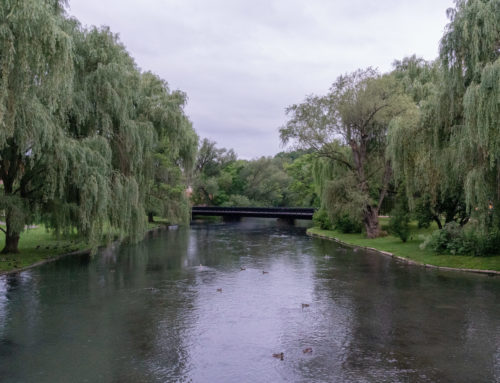By Serge Bielanko
‘History, despite its wrenching pain, cannot be unlived, but if faced with courage, need not be lived again.’
–Maya Angelou
Some people, for whatever the reason, can probably find ways to ascend that highest flight of creaky steps, walk into that small space at the top of the old Linn House over on North Allegheny Street, and stand there looking you in the eye, telling you they feel nothing much at all.
In which case you are likely in the presence of one of two kinds of people. A liar or a denier. And no, I don’k know which kind is worse. And quite frankly, at 46, I’m kind ofpast even mulling it over anymore. All I know at this point is this. A few weeks ago, having heard time and time again about a small room at the top of a very old house in Bellefonte that was once a part of the infamous Underground Railroad, I finally found myself climbing the final stairs to see for myself.
Except what I saw wasn’t what I expected.
And what I felt, well…let’s just say that I honestly had no idea.
There’s something up there.
There just is.
—
Backtrack with me.
The exhibit is called Underground Railroad: A Journey to Freedom.
TheA Underground Railroad, in case you aren’t quite sure, was a railroad by name only. Over the course of several decades leading up to the Civil War in 1861, the Underground Railroad was actually a trainless/trackless network of people who risked an enormous amount of their own freedom by helping African-American slaves flee the South in a quest for their own. Men, women, and children were hidden, fed, sheltered, and transported along clandestine routes by passionately committed strangers who believed beyond all else that slavery was both inhumane and illegal.
The journeys were perilous, of course, as aiding and abetting escaped slaves was considered a serious federal crime in the time before Lincoln and the War. And so the folks who did it anyway were considered nothing but criminals by the antiquated laws and lawmakers of the land. Yet, did it they did. And although their story has never yet been told by any Hollywood-types, the fact remains that the people who helped foster an Underground Railroad from the South all the way up through the Northern and Midwestern states to safety- and maybe ultimate freedom in Canada- were heroes. We throw that word around way too loosely these days.
But I don’t mind tossing it at the Americans who helped the Underground Railroad succeed.
Mudiwa Pettus, a Penn State doctoral candidate, wrote the spectacularA pamphletA that accompanies a visit. In it she tells of how Bellefonte residents, Mary Beth Wilson, who occupied Linn House in the 1840’s, and Jacob Valentine Thomas, who called it home in the 1850’s, are both widely believed to have been active in the Underground Railroad during their time in the home.
That would make them the Bellefonte people from long ago who we can probably call heroes today.
What the heck else would you call them?
—
Clunking up the stairs in the Linn House, an infamous, beautiful old home in a town filled with them, I am listening toA Patricia House, Executive Director of theA Bellefonte Art Museum for Centre County, as she tells me how this all came about.
“We’d heard stories about a secret room,” she confides. “But when we finally came up here and found this and realized what it was…” Her voice tails off.
We’re still not there yet though; we’re still not inside this room I’ve been wanting to experience for so long now. Life is dumb sometimes. We let ourselves put certain things off in the name of being busy. We don’t want to drive the ten or twenty miles to get to a place. “And where will we park when we get there?,” we moan to ourselves. We make excuses. I made excuses. But all that was out the window now. I am touring the museum here on this winter afternoon when it’s not even open so I can get to know House a little, work on some articles together to celebrate the museum’s 10th anniversary this year.
She’s been showing me the grand rooms filled with paintings and sculpture up until now, telling me about the artists from all over the world who’s work she has helped bring here since she arrived in these parts a decade ago from a wildly successful career running art museums out west.
She’s proud of this place and she should be. I stop on the stairs to write that line in my little reporter’s notebook that I bought last week at RiteAid.
Then, before I’m at all ready for what’s about to happen, Patricia House turns to me and smiles.
“Here we are,” she says, quietly. “Our secret room. The Underground Railroad.”
And we are. We’re there. Or as ‘there’ as there can be, I suppose. I’m instantly overcome by a heart that wants to speed up on me. I feel lightheaded and strange. There’s an aura, a feel to the room that certainly wasn’t something I was expecting. I figured I was going to experience this place like I’d experienced a hundred different cannons flung out all across the battlefield at Gettysburg. I’d be hit by some reverential awe, feel a tinge of sadness, move on to the next monument or whatever. But that’s not the case here. There’s not much in this room. There’s definitely no sweeping Gettysburg wind to remind you of the grand scale of everything at once here. It’s a tiny space floating high above the town. An attic.
There’s a small pillow on the ground in front of a piece of plexiglass and so I kneel down on it and peer in.
The painted figures of escaped slaves slam through me like ghosts coming at me from the dark. There are kids in there, huddled in the arms of their mother, I presume. There are tired looking men. There is fear and exhaustion and I bite my damn lip because you know why. Right here in my neck of the woods and how did I not see all this before now.
And how have you not seen it either?
I listen to Patricia House tell me more about the exhibit and I really appreciate her taking the time to do it, but truth be told, I don’t really hear the words she’s saying to me. My mind is messing with me. I feel inundated and overwhelmed. I don’t feel like I thought I would. I feel broken up and mesmerized. How did rooms like this ever happen?
How do they keep happening somewhere out there in this world today…right now…right this very second. The Underground Railroad is long gone. But the meanness that caused it all is alive and well, people.
—
I could write it out for hours for you and I’d never make it live in your head the way I want it to.
Rooms where escaped slaves once hid- holding one another, trying to believe in something they’d never believed in before- those kinds of rooms are mostly lost to the ages. We never knew they were there. They fall away forever, no writer dude on his knees on a pillow on a winter afternoon, losing his breath, trying to focus.
But listen, Bellefonte.
We have a room like that. It didn’t disappear. Once upon a time Patricia House and a bunch of donors and people who care about this town and the art and history here, they came together before it was all too late and they brought a room out of hiding. They kind of free’d something priceless that’d been hiding from us all.
But don’t take my one-man word for it, I’m begging you.
Just go.
The Underground Railroad: A Journey to Freedom Exhibit upstairs at the Linn House is permanent.
Like the unexpected, lingering rush I felt the moment I set foot up there.



